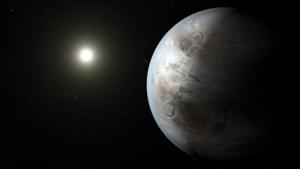Blog
Earth 2
24 July 2015
 NASA Ames/JPL-Caltech/T. Pyle
NASA Ames/JPL-Caltech/T. PyleNASA has announced confirmation of the most Earth-like planet yet.1 Known as Kepler-452b, it is a “super Earth” about 60% larger than our home planet. We don’t know its mass, but if it has a similar composition to Earth, then its mass is about 4 times Earth’s, and its surface gravity is about 1.6 gees. While that’s not too similar to Earth, what’s remarkable is its orbit. Kepler is a G2 star only 4% more massive than our own Sun, and this new planet orbits at a radius only 5% larger than Earths. The amount of light 452b receives from its star is almost identical to Earth.
We don’t have any direct evidence regarding 452b’s composition. It could be a cold dry world like Mars, or have a thick and toxic atmosphere like Venus. But it could also be a wet world with an atmosphere similar to ours. If that’s the case, then it would have a temperature similar to Earth’s, with liquid water lakes or oceans. It could have a strong magnetic field and be geologically active. It is within the realm of possibility that the planet would be habitable by terrestrial organisms. Kepler 452 is about 1.5 billion years older than our Sun, so this newly announced planet has been within the habitable zone of its star for 6 billion years, which is plenty of time for life to have evolved.
It’s important not to read too much into this. Kepler-452b could be completely inhospitable for lots of reasons, and we still don’t know if it is easy or difficult for life to arise on potentially habitable worlds. But this discovery does make one thing quite clear. Sun-like stars do indeed have Earth-like planets orbiting their habitable zones. Given the statistics of the exoplanets we’ve found thus far, such planets appear to be common. Perhaps extraordinarily so.
Jenkins, Jon M., et al. “Discovery and validation of Kepler-452b: a 1.6 R⨁ super Earth exoplanet in the habitable zone of a G2 star.” The Astronomical Journal 150.2 (2015): 56. ↩︎